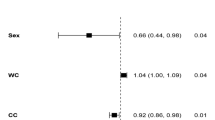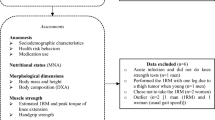Abstract
Background/Objectives:
There are positive associations between pulmonary function (PF) and fat-free mass as well as muscle strength. Contrarily, negative associations were found with indirect measures of visceral adipose tissue (VAT). We aimed to differentiate between associations of body composition and PF by assessing mediating and moderating effects of physical capabilities.
Subjects/Methods:
Cross-sectional data were assessed among 40 healthy, free-living elderly (20 males) aged 65.1–81.2 years (mean±s.d. age: 72.2±4.3 years; body mass index: 25.6±3.7 kg/m2). Total and regional skeletal muscle (SM), and adipose tissue (AT) were measured using whole-body magnetic resonance imaging. Muscle strength by handgrip dynamometry, physical activity (PA) by questionnaire, and physical performance by gait speed and sit-to-stand test (STS). Forced vital capacity (FVC) and forced expiratory volume in 1 s (FEV1) were assessed by spirometry.
Results:
Positive associations between height-standardized FVC (FVCI) as well as FEV1 (FEVI), and SM (r=0.435–0.520, P<0.05) were found; subcutaneous AT (SAT) and FVCI correlated negatively (r=−0.374; P<0.05). HGS and PA correlated positively with FEVI (r=0.456–0.608, P<0.05), HGS also with FVCI (r=0.595, P<0.05). Stepwise multiple regression using FVCI and FEVI as dependent variables, and total/thoracic SM, VAT, SAT, HGS, PA and physical performance as independent variables showed that (i) only HGS entered the regression for predicting FVCI (R2=0.351; standard error of estimation (SEE)=0.32 l), and (ii) HGS and PA explained 50% of FEVI (SEE=0.23 l). HGS mediated the relationship between SM and PF; the STS moderated the relationship between SM and FVCI.
Conclusions:
In healthy elderly, PF is positively associated with SM; physical capabilities mediate and moderate these relationships.
This is a preview of subscription content, access via your institution
Access options
Subscribe to this journal
Receive 12 print issues and online access
$259.00 per year
only $21.58 per issue
Buy this article
- Purchase on Springer Link
- Instant access to full article PDF
Prices may be subject to local taxes which are calculated during checkout


Similar content being viewed by others
References
Baumgartner RN, Stauber PM, McHugh D, Koehler KM, Garry PJ . Cross-sectional age differences in body composition in persons 60+ years of age. J Gerontol A Biol Sci Med Sci 1995; 50: M307–M316.
Gallagher D, Ruts E, Visser M, Heshka S, Baumgartner RN, Wang J et al. Weight stability masks sarcopenia in elderly men and women. Am J Physiol Endocrinol Metab 2000; 279: E366–E375.
Janssen I, Heymsfield SB, Wang ZM, Ross R . Skeletal muscle mass and distribution in 468 men and women aged 18-88 yr. J Appl Physiol 2000; 89: 81–88.
Prado CMM, Wells JCK, Smith SR, Stephan BCM, Siervo M . Sarcopenic obesity: a critical appraisal of the current evidence. Clin Nutr 2012; 31: 583–601.
Sharma G, Goodwin J . Effect of aging on respiratory system physiology and immunology. Clin Interv Aging 2006; 1: 253–260.
Sillanpää E, Stenroth L, Bijlsma AY, Rantanen T, MCPhee JS, Maden-Wilkinson TM et al. Associations between muscle strength, spirometric pulmonary function and mobility in healthy older adults. J Am Aging Assoc 2014; 36: 9667.
Kannel WB, Hubert H, Lew EA . Vital capacity as predictor of cardiovascular disease: the Framingham Study. Am Heart J 1983; 105: 311–315.
Hole DJ, Watt GC, Davey-Smith G, Hart CL, Gillis CR, Hawthorne VM . Impaired lung function and mortality risk in men and women: findings from the Renfrew and Paisley prospective population study. BMJ 1996; 313: 711–715.
Schols AMWJ, Broekhuizen R, Weling-Scheepers CA, Wouters EF . Body composition and mortality in chronic obstructive pulmonary disease. Am J Clin Nutr 2005; 82: 53–59.
Engelen MP, Schols AM, Does JD, Wouters EF . Skeletal muscle weakness is associated with wasting of extremity fat-free mass but not with airflow obstruction in patients with chronic obstructive pulmonary disease. Am J Clin Nutr 2000; 71: 733–738.
Santana H, Zoico E, Turcato E, Tosoni P, Bissoli L, Olivieri M et al. Relation between body composition, fat distribution, and lung function in elderly men. Am J Clin Nutr 2001; 73: 827–831.
Wannamethee SG, Shaper AG, Whincup PH . Body fat distribution, body composition, and respiratory function in elderly men. Am J Clin Nutr 2005; 82: 996–1003.
Rossi A, Fantin F, Di Francesco V, Guariento S, Giuliano K, Fontana G et al. Body composition and pulmonary function in the elderly: a 7-year longitudinal study. Int J Obes 2008; 32: 1423–1430.
Pekkarinen E, Vanninen E, Länsimies E, Kokkarinen J, Timonen KL . Relation between body composition, abdominal obesity, and lung function. Clin Physiol Funct Imaging 2012; 32: 83–88.
Babb TG, Wyrick BL, DeLorey DS, Chase PJ, Feng MY . Fat distribution and end-expiratory lung volume in lean and obese men and women. Chest 2008; 134: 704–711.
Rossi AP, Watson NL, Newman AB, Harris TB, Kritchevsky SB, Bauer DC et al. Effects of body composition and adipose tissue distribution on respriratory function in elderly men and women: the health, aging, and body compositon study. J Gerontol A Biol Sci Med Sci 2011; 66: 801–808.
Amara CE, Koval JJ, Paterson DH, Cunninham DA . Lung function in older humans: the contribution of body composition, physical activity and smoking. Ann Hum Biol 2001; 28: 522–536.
Bosy-Westphal A, Kossel E, Goele K, Later W, Hitze B, Settler U et al. Contribution of individual organ mass loss to weight loss-associated decline in resting energy expenditure. Am J Clin Nutr 2009; 90: 993–1001.
Quanjer PH, Stanojevic S, Cole TJ, Baur X, Hall GL, Culver BH et al. Multi-ethnic reference values for spirometry for the 3-95-yr age range: the global lung function 2012 equations. Eur Respir J 2012; 40: 1324–1343.
Cole TJ . Linear and proportional regression models in the prediction of ventilatory function. J R Statist Soc A 1975; 138: 297–338.
Härkönen R, Piirtomaa M, Alaranta H . Grip strength and hand position of the dynamometer in 204 Finnish adults. J Hand Surg Br 1993; 18: 129–132.
Washburn RA, Smith KW, Jette AM, Janney CA . The physical scale for the elderly (PASE): development and evaluation. J Clin Epidemiol 1993; 46: 153–162.
Cesari M, Kritchevsky SB, Newman AB, Simonsick EM, Harris TB, Penninx BW et al. Added value of physical performance measures in predicting adverse health-related events: results from the Health, Aging And Body Composition Study. J Am Geriatr Soc 2009; 57: 251–259.
Enright PL, Kronmal RA, Manolio TA, Schenker MB, Hyatt RE . Respiratory muscle strength in the elderly. Correlates and reference values. Am J Respir Crit Care Med 1994; 149: 430–438.
Cooper R, Kuh D, Hardy R, Mortality Review Group; FALCon and HALCyon Study Teams. Objectively measured physical capability levels and mortality: a systematic review and meta-analysis. BMJ 2010; 341: c4467.
van der Palen J, Rea TD, Manolio TA, Lumley T, Newman AB, Tracy RP et al. Respiratory muscle strength and the risk of incident cardiovascular events. Thorax 2004; 59: 1063–1067.
Lusardi MM, Pellecchia GL, Schulman M . Functional performance in community living older adults. J Geriatr Phys Ther 2003; 26: 14–22.
Costes F, Celle S, Garet M, Kossovsky M, Roche F, Barthélémy JC . Identification and comparison of the predictors of maximal inspiratory force and handgrip in a healthy elderly population. The proof study. Clin Nutr 2016; 35: 963–967.
Ochs-Balcom HM, Grant BJ, Muti P, Sempos CT, Freudenheim JL, Trevisan M et al. Pulmonary function and abdominal adiposity in the general population. Chest 2006; 129: 853–862.
Zavorsky GS, Murias JM, Kim DJ, Sylvestre JL, Christou NV . Waist-to-hip ratio is associated with pulmonary gas exchange in the morbidly obese. Chest 2007; 131: 362–367.
Parameswaran K, Todd DC, Soth M . Altered respiratory physiology in obesity. Can Respir J 2006; 13: 203–210.
Chan ED, Welsh CH . Geriatric respiratory medicine. Chest 1998; 114: 1704–1733.
Mohamed EI, Maiolo C, Iacopino L, Pepe M, Di Daniele N, De Lorenzo A . The impact of body-weight components on forced spirometry in health Italians. Lung 2002; 180: 149–159.
Acknowledgements
The study was funded by a grant of the Danone Institute- Nutrition for Health, Germany (2013/13). We thank Britta Jux and the Clinic for Diagnostic Radiology, University medical Center Schleswig-Holstein, Kiel (Germany) for the help with MRI scanning.
Author information
Authors and Affiliations
Corresponding author
Ethics declarations
Competing interests
The authors declare no conflict of interest.
Rights and permissions
About this article
Cite this article
Schweitzer, L., Geisler, C., Johannsen, M. et al. Associations between body composition, physical capabilities and pulmonary function in healthy older adults. Eur J Clin Nutr 71, 389–394 (2017). https://doi.org/10.1038/ejcn.2016.146
Received:
Revised:
Accepted:
Published:
Issue Date:
DOI: https://doi.org/10.1038/ejcn.2016.146
This article is cited by
-
Physical activity and lung function association in a healthy community-dwelling European population
BMC Pulmonary Medicine (2024)
-
Multicompartment body composition analysis in older adults: a cross-sectional study
BMC Geriatrics (2023)
-
Visceral adiposity and respiratory outcomes in children and adults: a systematic review
International Journal of Obesity (2022)
-
Nonlinear relationship between visceral adiposity index and lung function: a population-based study
Respiratory Research (2021)
-
Visceral adiposity index is associated with lung function impairment: a population-based study
Respiratory Research (2021)



